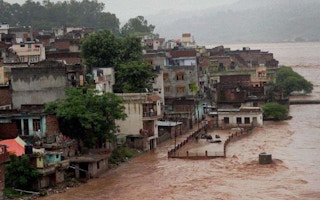Heavy rainfalls battered the western Himalayas last week due to a clash between monsoon currents and winds from the Caspian Sea. The Srinagar weather station – in the summer capital of the Indian state of Jammu and Kashmir – recorded 250 mm of rain between September 3-6.
The resultant floods – which have killed almost 400 people in India and Pakistan and displaced tens of thousands more – were perhaps inevitable. But they would not have become so devastating if the riverbeds and lakebeds had not been raised by silt, while their banks were encroached upon by ill-planned buildings.
There are four reasons why the floods have caused so much damage:
- deforestation in the catchment areas of rivers – especially Jhelum, Chenab and Indus – and of streams;
- unplanned construction of buildings and roads, especially in the floodplains of the rivers and the banks of the lakes;
- rampant and unchecked dumping of garbage in the rivers and lakes;
- overuse of chemical fertilisers by farmers.
The situation is identical in adjacent regions of Pakistan – which have been just as badly hit by the floods. Deforestation is particularly rampant in the Gilgit-Baltistan and Khyber Pakhtunkhwa provinces of Pakistan.
“
Whenever a road is built in the Himalayas, it destabilises the slope above, and chokes the slope and the riverbed below with rubbish. When it rains heavily, the water has can only go out in the form of a flood
With the death toll in the two countries nearing 400, authorities are understandably putting all their energies into the rescue of stranded residents, restoring communications networks and getting relief supplies into the valley. With parts of the Jammu-Srinagar road washed away, this process is going to take some time.
The worry is, after the immediate rescue and relief work ends, it will be business as usual. In that case, what is now the worst flood in Kashmir in six decades may become the new normal.
With Uttarakhand government apparently having learnt few lessons after the devastating floods in that Indian Himalayan state last year, it is not an idle worry.
Taking the factors that exacerbated the floods one by one, deforestation has long been a major problem in the northern half of the Kashmir valley, in adjacent parts of Pakistan-administered Kashmir and in Gilgit-Baltistan.
With all forestry officials seeking to avoid a posting in a terrorism-affected area, the timber mafia has had a field day, even moving to the borders of the famous Dachigam reserve forest – the only refuge of the famous and endangered Kashmiri red deer, the Hangul.
Without the roots to hold the soil on the steep mountain slopes, it has all been washing down to the streams in the form of silt, and raising the riverbeds. The obvious consequence – the water carrying capacity of the streams and rivers is much reduced.
Coming to the second reason, for decades the elite in the Kashmir valley has been building fancy villas right on the floodplains of rivers and streams, sometimes even on tiny islands in the middle of the river. The process has been repeated and accelerated on the banks of famous lakes like Dal and Nageen in Srinagar, with some hotels and restaurants even being built with their foundations in the lake – a result of the tourism boom.
To the unplanned and illegal construction, add ill-planned road building. India has excellent guidelines on how roads should be built in the mountains, complete with how they should be graded and where the refuse should be taken.
But there is not a single example of any government or private road builder following these guidelines. The result is that whenever a road is built in the Himalayas, it destabilises the slope above, and chokes the slope and the riverbed below with rubbish. When it rains heavily, the water has can only go out in the form of a flood.
For years, urban planners have bemoaned the lack of solid waste management in Kashmir, and have been consistently ignored. Hardly any tourist enjoying a stay in a Dal Lake houseboat is aware that all the garbage from the kitchen and the toilets goes straight into the lake. Much of the lake is choked with algae as a result.
As the Jhelum River meanders through Srinagar, every neighbourhood adds its untreated household garbage to the river – once again a recipe for choked riverbeds and lakebeds and for the water to overflow whenever it rains heavily.
Overuse of chemical fertilisers, especially in the fruit orchards throughout Kashmir, also exacerbates flooding. The excess fertiliser gets washed into streams and rivers, where it causes eutrophication, and again leads to algae blooms which choke waterways.
With the natural flow of water hindered in every possible way, when it rains heavily, it floods.
Observers are bemoaning that Srinagar is looking like a vast lake. Urban planners, environmentalists or anybody with common sense is not surprised. Without immediate corrective action, the calamity is likely to strike again.

















